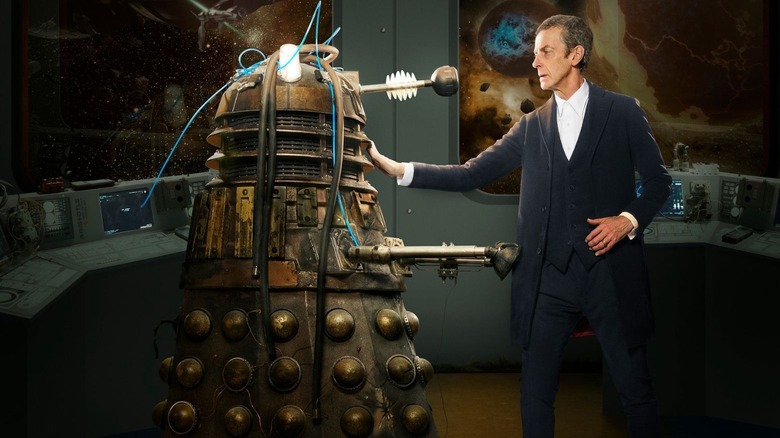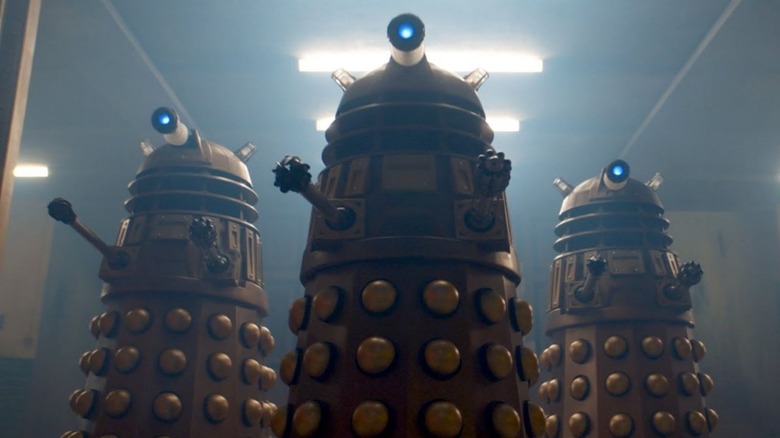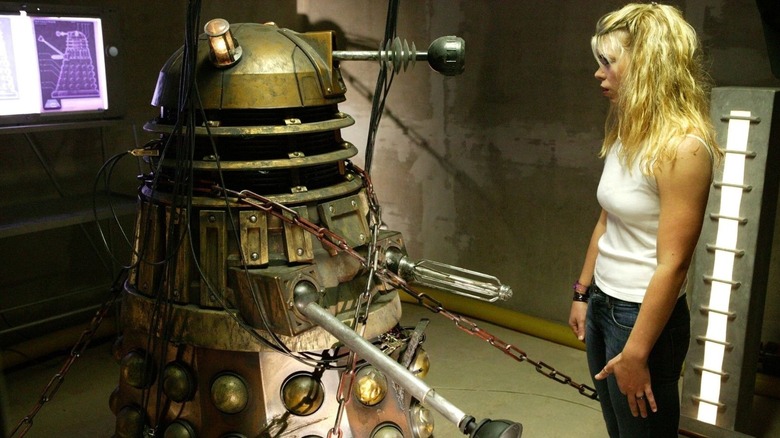Making Doctor Who's Daleks Move Wasn't Exactly Easy
Whovian or not, you must be familiar with the Daleks. These mutated blobs that hide inside mini tanks were created by Davros, a mad scientist type from the planet Skaro, and are very fond of obliterating everything and everyone that came in their way.
They're one of the most iconic villains in the sci-fi series "Doctor Who" and have regularly appeared on the show since its first season was released in 1963. Belonging to a race of hostile extraterrestrial alien machine-like organisms, they resemble human-sized tanks with the addition of a plunger and a whisk. Daleks often glide around floors declaring "Exterminate!" with much enthusiasm, unlike any extraterrestrial "Doctor Who" monster we've seen before. Screenwriter Terry Nation created the Daleks, and designer Raymond Cusick brought them to life — and despite their design changing slightly over the years, these monsters have continued to enjoy their position as a mainstay of the popular sci-fi series.
Daleks are just one of the Doctor's greatest archenemies — and it turns out, they were just as challenging to control for the show's production team, too!
A tricky, tricky job
Daleks are known for their lack of compassion and desire to exterminate every other being that is not Dalek. Over the years, they proved very difficult for the Doctor to deal with, and you'd be surprised to hear it was just as hard to make them work throughout the show's filming.
As seen in "Doctor Who," the Daleks are controlled by a mutated lump of flesh that sits inside the alien machine. But while filming their scenes, the Daleks needed to be handled very differently.
During the show's first season in the '60s, the Daleks were controlled by a person sitting inside (there is no real flesh monster controlling it, sorry to disappoint). The prop was built in two pieces; an operator would step into the lower section, after which the top would be secured. The operators would look outside from between the cylindrical louvers beneath the dome, which was lined with mesh to conceal their faces (via David Howe's 1997 book "Doctor Who: A Book of Monsters.") It was a very inconvenient task since the prop was heavy and claustrophobia-inducing, which would make it tricky for the person seated inside to carry out their jobs successfully.
The operator seated inside the hollow prop moved the on-screen alien manually with their feet. The Dalek was designed with wheels on its base, contributing to its effortless gliding motion. The arm attachments were also manipulated by the operator, as well as the head rotation, the movement of the eyestalk, and the flashing of light on their head had to be in sync with the voice actor's work — it was an incredibly tedious job for only one person.
The 'Doctor Who' revival made it easier
When the show was revived in 2005, with Christopher Eccleston stepping in to portray the ninth incarnation of the Time Lord, the Dalek was made more accessible to move around. Two people now controlled a single Dalek — the operator seated inside was responsible for moving the body, the whisk/exterminator, and the plunger. The second person used a remote control to move the head and eyestalk, making it easier for the operators to focus on moving through scenes smoothly (via The Life of a Dalek Operator — Doctor Who Confidential).
"It's all about the legs, really. If you've got long legs, you're in trouble," shared Anthony Spargo, a Dalek operator, during a behind-the-scenes moment with Doctor Who Confidential.
Operating a Dalek might have been easily one of the most demanding assignments on the "Doctor Who" set. At least it's more straightforward now, and the operator doesn't need to multitask to make it work! Here's hoping we get to see more of these cranky creatures in series 14!


